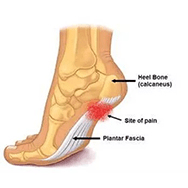Signs You Might Need Orthotics

Plantar Fasciitis
Morning heel pain or heel pain after rest.
Symptoms: Pain in the heels that begins from your first few steps in the morning or after being off of your feet for a long time with a duration of 5 minutes or longer.
Plantar fasciitis is a common ailment seen by foot care specialists. The most common symptom is pain in the heel during the first few steps in the morning as one gets out of bed. Some people, also experience pain anytime they are non-weight-bearing for more than fifteen minutes and rise to a weight-bearing position.
The pain, or discomfort, can be felt at the plantar fascia insertion point, up through the arch, just before the balls of the feet. This pain mimics a tearing-like feeling when weight-bearing first occurs, which is scar tissue being torn from the micro-trauma caused the previous day, or weight-bearing event.
Depending on the damage caused, recovery can take a few days, or up to a few weeks. Fortunately, custom orthotics show a high success rate to relieve the pain of plantar fasciitis.
Bob and Brad – YouTube Famous Physiotherapists – show us 5 exercises to do each day to help alleviate symptoms from Plantar Fasciitis. Check with your own Doctor before starting any new exercises or treatment.


Heel Spurs
Heel Spurs are calcium deposits around the heel area of the foot that is typically caused by tension, abrasion, and or inflammation of the plantar fascia attachment to the heal.
Symptoms: The most common complaint is a dull ache and intermittent sharp pain on the inside area of the heel. Pain is typically the worst first in the morning, after rest, or after prolonged standing wearing thin-soled footwear with improper support.


Flat Feet
Flat feet is a condition that occurs when the arch of the foot has fallen and comes in contact with the ground.
Symptoms: Collapsed Instep. The posterior tibial tendon is the main support structure of the arch. This tendon can be overloaded and can become inflamed or even torn.
Years of wear and tear can weaken this tendon causing it to collapse.

Bob and Brad share their opinions on the treatment of Morton’s Neuroma symptoms at home. Always consult a medical professional before trying any treatment, even at home.
Morton’s Neuroma
An irritation that commonly affects the nerve that travels between the third and fourth toes causing pain and burning in the forefoot area.
Symptoms: The most common complaint is a feeling of walking on a marble. You can also feel a sharp pain and burning in the ball of the foot. You may also feel numbness over the ball of the foot.
Morton’s neuroma is a painful condition that affects the ball of your foot, most commonly, but not limited to, the area between your third and fourth toes. Morton’s neuroma may feel as if you are standing on a pebble in your shoe or on a fold in your sock.
Other symptoms are: “pins and needles” feeling in the toes, an electric shock feeling, or numbness. A qualified foot care specialist can offer relief.
As always – consult a medical professional before attempting any treatments.

Bunions
Bunions are commonly defined as the enlargement of the inner portion of the joint at the base of the big toe.
Many studies show that bunions occur in women 10 times more frequently. It is shown that high heels and tight-fitting shoes can increase the risk of bunions.
Symptoms: Big toe soreness and swelling near the base.
Manufactured by licensed Pedorthists educated at Western University in Pedorthics, in good standing with the College of Pedorthics, the Pedorthic Association of Canada and the Pedorthic Footwear Association of Canada, with a combined 30 years experience.
Jeff Lewis, Owner and Certified Pedorthist, is currently studying out sole invention at London University Hospital under Dr. Ted Vasarhelyi (Orthopaedic Surgeon).
At Garnet Orthopedic Solutions, we have customers visiting us from across:

